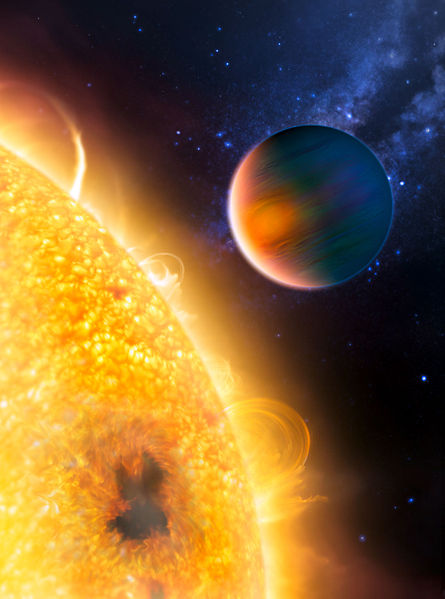Exoplanet exploration
Interview with
Carole Haswell talks Graihagh Jackson through how and why she studies planets  beyond our own solar system...
beyond our own solar system...
Carole - My name is Carole Haswell. I'm an astrophysicist at the Open University where I do research on exoplanets.
Graihagh - And Carole uses this transiting method that David was talking about to study exoplanets. But what really amazed me about Carole was that when she heard of a particular transiting exoplanet, it literally changed the course of her life...
Carole - As a very young child I knew that I wanted to be an astronomer and, like many young people, I thought that I wanted to do cosmology just because seemed like the ultimate thing to do. And then, I think, as I got older and actually started studying at university, then I realised that actually, cosmology seemed to me to be a little bit abstract and removed from things that I could identify with and so, at that point, I decided that I wanted to work instead on things closer to home.
So, I in fact started my research career still doing something that's quite far out. I was working on accretion around black hole binary star systems and I did enjoy that but in, I think it was about 2003, I saw a paper which had observed an exoplanet using the Hubble space telescope. And when a planet passes in front of a star from our point of view, it blocks say 1% of the light from the star and produces a very subtle dip every time it goes round the orbit. But this particular paper, they had used the Hubble space telescope to look in the ultraviolet and they had seen, instead of a 1% very subtle dip, a 15% diminishing in the light from the star and this told us that the planet was actually surrounded by a huge cloud of hydrogen. And, at that point, I thought this is just too exciting and exoplanets are the way to go.
Graihagh - I mean obviously it had a profound importance for you but what was the importance of that discovery more generally in the scientific community I'm thinking?
Carole - What that paved the way for was the whole field of being able to actually assess the chemical composition of exoplanets. So, here you have a planet orbiting a distant star and because the planet is surrounded by some gas, which is translucent. The gas is made up of atoms and ions which absorb light at particular wavelengths.
Graihagh - I think of it like a looking at a rainbow. Whilst hydrogen may block one frequency of light - red let's say - methane might block green. So you have a rainbow - or spectrum of light - that goes mm and YELLOW and PINK and mm! PURPLE and ORANGE and BLUE!
And by looking at what's colours are missing you can work out what elements are found in the atmosphere of this extremely, distant planet. Soooooo coool.
Carole - So it really opened the field for being able to actually measure what planets outside our own solar system are made of or at least what their atmospheres and the surround gas cloud is made of.
Graihagh - What I find absolutely insane is that these exoplanets are a long, long, way away. I mean, how far are we talking in light years?
Carole - Well the very, very closest star is about 4 light years away and, obviously, most stars are very much further away than that - hundreds or more light years away. So the transit method has found thousands planets or planet candidates. Not all of them have been completely verified but it's been extremely successful at finding planets
Graihagh - And like David's DIY to watching the Mercury transit, Carole also has a similar attitude...
Carole - There have been missions, projects like SuperWASP, which is a UK project which I, and many of my colleagues, were involved in which actually used very, very cheap equipment. Some of it I actually bought on eBay...
Graihagh - No really!
Carole - Yes. So because it's a fairly simple measurement just to measure the brightness of the star, we were able to use camera lenses that had actually been designed for doing things like theatre photography. We put them on a telescope mount and pointed them to the sky and used those to measure the brightness of thousand of stars over and over again. And the SuperWASP project has now discovered I think about 150 or 160 planets using that very modest equipment
Graihagh - Something else to try at home guys, seriously... Perhaps you could even name an exoplanet after yourself?? Anyway, back to the rainbow stuff, what actual elements have been discovered so far?
Carole - Ok so there's been quite a number elements detected and the other early discoveries that I should mention was the detection of sodium in the atmosphere of the very first known transiting exoplanet, and there have been many, many more discoveries including things as heavy as iron.
Graihagh - And I'm sure Carole would agree, there are probably many more elements to discovered when it comes to exoplanets!
- Previous Searching for signs of life
- Next Want to see Mercury in 2016?










Comments
Add a comment